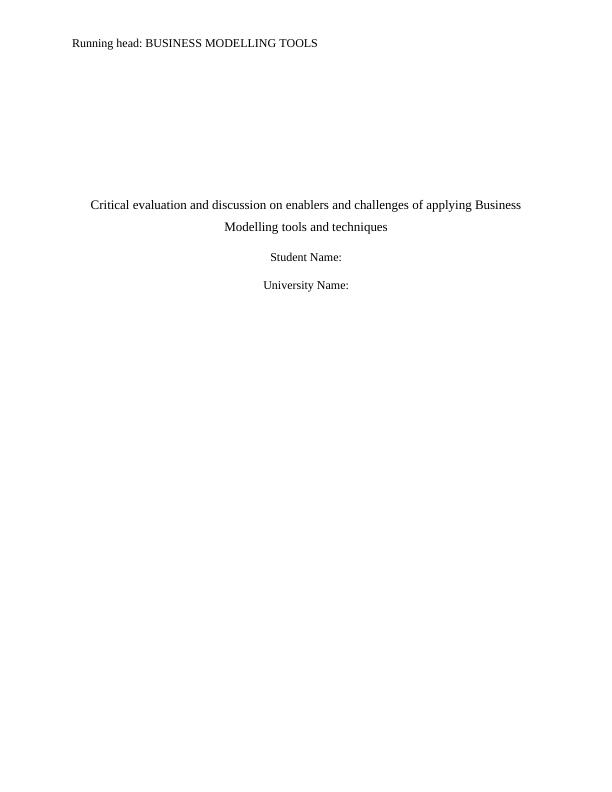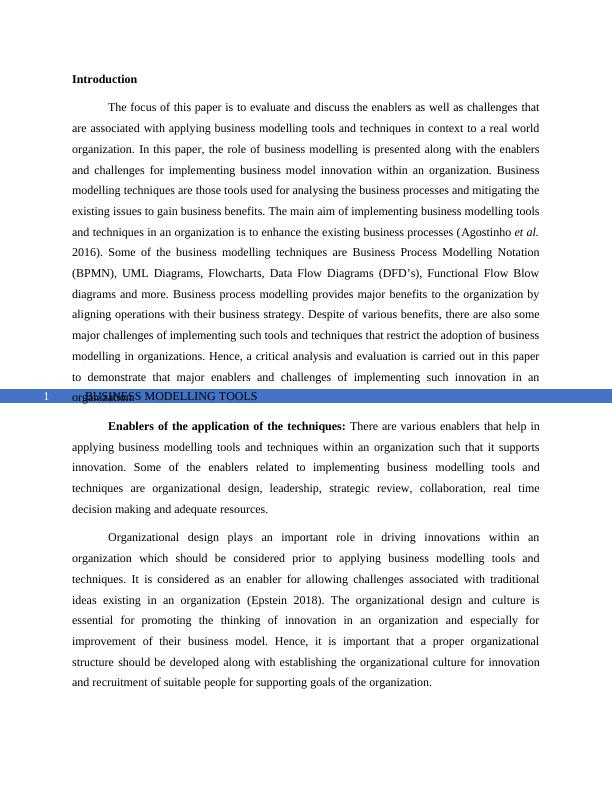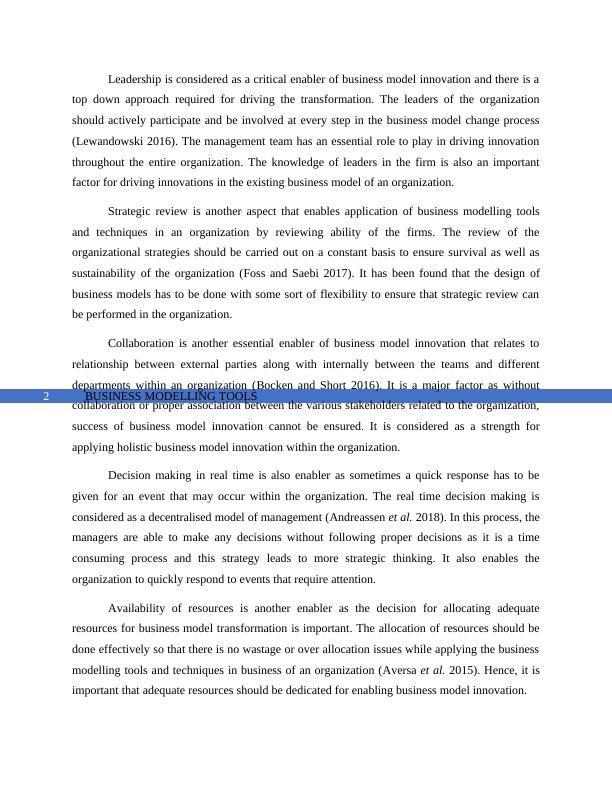7BSP1174 Business Modelling Tools
8 Pages2447 Words45 Views
Business Modelling Tools (7BSP1174)
Added on 2021-10-10
7BSP1174 Business Modelling Tools
Business Modelling Tools (7BSP1174)
Added on 2021-10-10
ShareRelated Documents
Running head: BUSINESS MODELLING TOOLS
Critical evaluation and discussion on enablers and challenges of applying Business
Modelling tools and techniques
Student Name:
University Name:
Critical evaluation and discussion on enablers and challenges of applying Business
Modelling tools and techniques
Student Name:
University Name:

BUSINESS MODELLING TOOLS1
Introduction
The focus of this paper is to evaluate and discuss the enablers as well as challenges that
are associated with applying business modelling tools and techniques in context to a real world
organization. In this paper, the role of business modelling is presented along with the enablers
and challenges for implementing business model innovation within an organization. Business
modelling techniques are those tools used for analysing the business processes and mitigating the
existing issues to gain business benefits. The main aim of implementing business modelling tools
and techniques in an organization is to enhance the existing business processes (Agostinho et al.
2016). Some of the business modelling techniques are Business Process Modelling Notation
(BPMN), UML Diagrams, Flowcharts, Data Flow Diagrams (DFD’s), Functional Flow Blow
diagrams and more. Business process modelling provides major benefits to the organization by
aligning operations with their business strategy. Despite of various benefits, there are also some
major challenges of implementing such tools and techniques that restrict the adoption of business
modelling in organizations. Hence, a critical analysis and evaluation is carried out in this paper
to demonstrate that major enablers and challenges of implementing such innovation in an
organization.
Enablers of the application of the techniques: There are various enablers that help in
applying business modelling tools and techniques within an organization such that it supports
innovation. Some of the enablers related to implementing business modelling tools and
techniques are organizational design, leadership, strategic review, collaboration, real time
decision making and adequate resources.
Organizational design plays an important role in driving innovations within an
organization which should be considered prior to applying business modelling tools and
techniques. It is considered as an enabler for allowing challenges associated with traditional
ideas existing in an organization (Epstein 2018). The organizational design and culture is
essential for promoting the thinking of innovation in an organization and especially for
improvement of their business model. Hence, it is important that a proper organizational
structure should be developed along with establishing the organizational culture for innovation
and recruitment of suitable people for supporting goals of the organization.
Introduction
The focus of this paper is to evaluate and discuss the enablers as well as challenges that
are associated with applying business modelling tools and techniques in context to a real world
organization. In this paper, the role of business modelling is presented along with the enablers
and challenges for implementing business model innovation within an organization. Business
modelling techniques are those tools used for analysing the business processes and mitigating the
existing issues to gain business benefits. The main aim of implementing business modelling tools
and techniques in an organization is to enhance the existing business processes (Agostinho et al.
2016). Some of the business modelling techniques are Business Process Modelling Notation
(BPMN), UML Diagrams, Flowcharts, Data Flow Diagrams (DFD’s), Functional Flow Blow
diagrams and more. Business process modelling provides major benefits to the organization by
aligning operations with their business strategy. Despite of various benefits, there are also some
major challenges of implementing such tools and techniques that restrict the adoption of business
modelling in organizations. Hence, a critical analysis and evaluation is carried out in this paper
to demonstrate that major enablers and challenges of implementing such innovation in an
organization.
Enablers of the application of the techniques: There are various enablers that help in
applying business modelling tools and techniques within an organization such that it supports
innovation. Some of the enablers related to implementing business modelling tools and
techniques are organizational design, leadership, strategic review, collaboration, real time
decision making and adequate resources.
Organizational design plays an important role in driving innovations within an
organization which should be considered prior to applying business modelling tools and
techniques. It is considered as an enabler for allowing challenges associated with traditional
ideas existing in an organization (Epstein 2018). The organizational design and culture is
essential for promoting the thinking of innovation in an organization and especially for
improvement of their business model. Hence, it is important that a proper organizational
structure should be developed along with establishing the organizational culture for innovation
and recruitment of suitable people for supporting goals of the organization.

BUSINESS MODELLING TOOLS2
Leadership is considered as a critical enabler of business model innovation and there is a
top down approach required for driving the transformation. The leaders of the organization
should actively participate and be involved at every step in the business model change process
(Lewandowski 2016). The management team has an essential role to play in driving innovation
throughout the entire organization. The knowledge of leaders in the firm is also an important
factor for driving innovations in the existing business model of an organization.
Strategic review is another aspect that enables application of business modelling tools
and techniques in an organization by reviewing ability of the firms. The review of the
organizational strategies should be carried out on a constant basis to ensure survival as well as
sustainability of the organization (Foss and Saebi 2017). It has been found that the design of
business models has to be done with some sort of flexibility to ensure that strategic review can
be performed in the organization.
Collaboration is another essential enabler of business model innovation that relates to
relationship between external parties along with internally between the teams and different
departments within an organization (Bocken and Short 2016). It is a major factor as without
collaboration or proper association between the various stakeholders related to the organization,
success of business model innovation cannot be ensured. It is considered as a strength for
applying holistic business model innovation within the organization.
Decision making in real time is also enabler as sometimes a quick response has to be
given for an event that may occur within the organization. The real time decision making is
considered as a decentralised model of management (Andreassen et al. 2018). In this process, the
managers are able to make any decisions without following proper decisions as it is a time
consuming process and this strategy leads to more strategic thinking. It also enables the
organization to quickly respond to events that require attention.
Availability of resources is another enabler as the decision for allocating adequate
resources for business model transformation is important. The allocation of resources should be
done effectively so that there is no wastage or over allocation issues while applying the business
modelling tools and techniques in business of an organization (Aversa et al. 2015). Hence, it is
important that adequate resources should be dedicated for enabling business model innovation.
Leadership is considered as a critical enabler of business model innovation and there is a
top down approach required for driving the transformation. The leaders of the organization
should actively participate and be involved at every step in the business model change process
(Lewandowski 2016). The management team has an essential role to play in driving innovation
throughout the entire organization. The knowledge of leaders in the firm is also an important
factor for driving innovations in the existing business model of an organization.
Strategic review is another aspect that enables application of business modelling tools
and techniques in an organization by reviewing ability of the firms. The review of the
organizational strategies should be carried out on a constant basis to ensure survival as well as
sustainability of the organization (Foss and Saebi 2017). It has been found that the design of
business models has to be done with some sort of flexibility to ensure that strategic review can
be performed in the organization.
Collaboration is another essential enabler of business model innovation that relates to
relationship between external parties along with internally between the teams and different
departments within an organization (Bocken and Short 2016). It is a major factor as without
collaboration or proper association between the various stakeholders related to the organization,
success of business model innovation cannot be ensured. It is considered as a strength for
applying holistic business model innovation within the organization.
Decision making in real time is also enabler as sometimes a quick response has to be
given for an event that may occur within the organization. The real time decision making is
considered as a decentralised model of management (Andreassen et al. 2018). In this process, the
managers are able to make any decisions without following proper decisions as it is a time
consuming process and this strategy leads to more strategic thinking. It also enables the
organization to quickly respond to events that require attention.
Availability of resources is another enabler as the decision for allocating adequate
resources for business model transformation is important. The allocation of resources should be
done effectively so that there is no wastage or over allocation issues while applying the business
modelling tools and techniques in business of an organization (Aversa et al. 2015). Hence, it is
important that adequate resources should be dedicated for enabling business model innovation.

End of preview
Want to access all the pages? Upload your documents or become a member.
Related Documents
Business Process Modelling: Approaches, Tools, Benefits, Challenges, Security and Governancelg...
|11
|1765
|319
Analysis of Danone Japan Essaylg...
|13
|2593
|89
Enterprise System: A Case Study of Twiga Companylg...
|13
|2813
|269
Role of Innovation Management in Global Businesslg...
|14
|3560
|38
Design Thinking Techniqueslg...
|9
|1847
|381
Business Process Management for Tulloch Airlg...
|19
|3983
|81
